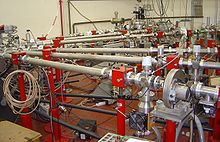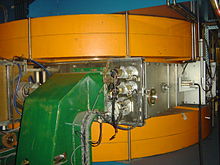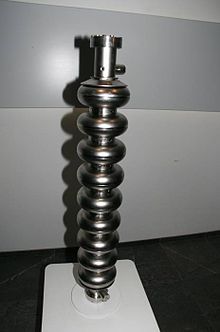Particle accelerator
A particle accelerator is a device or a system in which electrically charged particles (e.g. elementary particles , atomic nuclei , ionized atoms or molecules ) are accelerated to high speeds by electric fields . There is generally a vacuum in the interior of the accelerator . Accelerator physics describes the physical laws and modes of operation of the various types of particle accelerators .
Depending on the type of particle and accelerator, the accelerated particles can almost reach the speed of light . Your kinetic energy is then a multiple of your own rest energy . In these cases, the special theory of relativity describes the movement of particles.
The largest accelerator facilities are used in basic research (e.g. in high-energy physics ) in order to investigate the fundamental interactions of matter with the high-energy particles and to research the smallest structures. In addition, particle accelerators are also becoming increasingly important in medicine and for many industrial applications.
Large accelerators are often referred to in technical jargon , but somewhat misleadingly, as "machines".
History of development towards ever higher energies
Until around 1950: the MeV area



The first accelerators - not yet so named - worked with direct voltages . Karl Ferdinand Braun developed the Braunsche tube ( cathode ray tube ) in 1897 , which Max Dieckmann used as an image writer in 1906 . In the further development as a television tube, it dominated the television technology of the 20th century. In the cathode ray tube, electrons are accelerated towards a fluorescent screen. The electron gun it contains is also used in the electron microscope and today's electron accelerators .
The DC voltage accelerators include the Cockcroft-Walton accelerator and the Van de Graaff accelerator with particle energies of mostly a few MeV (megaelectron volts). In 1932, John Cockcroft and Ernest Walton succeeded in initiating a nuclear reaction on light atomic nuclei for the first time, using protons accelerated in this way , which was then known as “nuclear destruction”.
In order to achieve higher energies, Rolf Wideröe proposed in 1929 to use high-frequency alternating fields between cylinder electrodes that are arranged one behind the other on a common axis. The lengths of the cylinders (increasing according to the increasing speed of the particles) and the frequency are adjusted so that the particles are accelerated between the electrodes.
Almost at the same time, Ernest Lawrence developed the cyclotron . The first cyclotron was built in Berkeley from 1930 in collaboration with M. Stanley Livingston . In it, the charged particles move in a magnetic field on a spiral path from the center outwards and are regularly accelerated as they pass the gap between two D-shaped electrodes. Today's cyclotrons reach particle energies of up to a few 100 MeV.
Another type of orbital accelerator with a spiral orbit that was only suitable for light particles such as electrons was the betatron (Wideröe, Kerst , Max Steenbeck ). It had no electrodes, but the electric field required for acceleration was induced by changing the magnetic field over time . Around 1950, Betatron accelerated electrons up to 300 MeV.
From around 1950: the GeV area
The size of the necessary vacuum chamber and the magnets limit the construction possibilities of cyclotrons. The next step on the way to ever higher particle energy was therefore the acceleration on a path that remained constant despite the increasing energy, either in a straight arrangement ( linear accelerator ) or as an orbit in ring accelerators with regularly arranged individual deflection magnets. The original Wideröe principle was used again for the acceleration, but instead of between cylinder electrodes it takes place in specially shaped cavity resonators . In modern systems, these are designed as superconducting as possible to save energy . Superconductivity is also used in some cases for the magnetic coils.
Linear accelerators have the advantage that the particles do not suffer any energy losses from synchrotron radiation , as is unavoidable with ring accelerators. (However, there are also uses of synchrotron radiation and therefore electron synchrotrons operated specifically to generate it, see below.) Ring accelerators, on the other hand, have the advantage that the same acceleration units are used every time the particle packet circulates, and are therefore more economical.
Such ring accelerators, in which the acceleration and deflection of the particles accelerated to almost the speed of light are synchronized ( synchrotron ), were based on the ideas of Vladimir Iossifowitsch Weksler (from the Lebedew Institute ) and Edwin McMillan (in Berkeley) from the mid-1940s after the second World War II projected, the Bevatron by Lawrence in Berkeley (1954) and the Cosmotron in Brookhaven (1952 under the direction of Livingston). With the Bevatron, protons were accelerated to around 6 GeV (gigaelectron volts).
An important advance was the invention of “strong focus” in the early 1950s. The deflection magnets were provided with pole pieces that are alternately bevelled on both sides, so that the magnetic fields transverse to the direction of flight of the particles have gradients with alternating directions. This results in a stabilization (focusing) of the particle trajectories. In relation to the deflection of a particle in the transverse direction, it clearly corresponds to the arrangement of converging and diverging lenses for light one behind the other, with focusing as a net effect. The idea came from Ernest Courant , Livingston and Hartland Snyder in the USA (and independently before that from Nicholas Christofilos ). This enabled the construction of proton synchrotrons in the 30 GeV range at CERN ( Proton Synchrotron , PS , 1960) and in Brookhaven ( Alternating Gradient Synchrotron , AGS , 1960). Today (2015) the largest synchrotron facility, the Large Hadron Collider , accelerated protons to 6.5 TeV.

High-energy accelerators for electrons only came to the fore in the 1960s. Examples are the SLAC linear accelerator and the DESY synchrotron . The International Linear Collider ILC, planned in global cooperation, is to have a total length of 30 km and enable electron-positron collisions with 500 GeV or more. The illustrated cavity resonator developed as an acceleration element for this consists of nine elliptically shaped cells (rotational ellipsoids ). The length of a single cell is chosen so that the electric field of the wave is reversed when a particle enters the next cell. At typical operating temperatures of around 2 K, the niobium cavity is superconducting and requires less energy to operate than conventional cavities made of copper. With this type of resonator, an energy gain of more than 40 MeV per meter has been achieved.
At the end of the 1960s, the design and construction of large accelerators for heavy ions, such as UNILAC at the GSI Helmholtz Center for Heavy Ion Research, began . It accelerates ions of any mass number to about 11 MeV / u (megaelectron volts per atomic mass unit ).
Storage rings
Another important concept that was developed in the 1960s is the storage ring , a synchrotron that does not accelerate the particles but instead collects them with constant energy and "stores" them until the beam reaches a high current strength. The storage ring idea was propagated in the west by Bruno Touschek (around 1960), based on whose ideas the first storage ring was built in Frascati in 1961, followed by Stanford (CBX, based on the ideas of Gerard Kitchen O'Neill ) and storage rings in Russia, where Budker had similar ideas.
Storage rings for electrons serve today (2013) mainly as sources for synchrotron radiation. Storage rings for ions are used in particle physics, especially in the form of colliders . These are systems with two beams rotating in opposite directions; Collisions (Engl. Collision , collision) of these particles allow nearly complete conversion of kinetic energy into new particles (see Colliding Beam Experiment ).
Examples of storage rings are:
- SPEAR (Stanford Positron Electron Asymmetric Ring) at the SLAC in Stanford (from 1972, electron-positron collider with twice 4 GeV), where charmonium and tau-lepton were discovered.
- at CERN the Intersecting Storage Rings (ISR) (Proton-Antiproton, twice 31 GeV, from 1971), the SPS (expanded to Proton-Antiproton Collider from 1981, twice 450 GeV), the Large Electron-Positron Collider (LEP, 1989 to 2000, twice 104 GeV in LEP II) and today's Large Hadron Collider (Proton-Proton Collider, currently the largest accelerator to date with twice 6.5 TeV)
- the Tevatron at Fermilab (from 1987, Proton-Antiproton Collider, twice 900 GeV, from 2002 with twice 1 TeV; shut down in 2011)
- the ESR, experimental storage ring at the GSI Helmholtz Center for Heavy Ion Research
- or the various storage rings at DESY (Doris, Petra, Hera).
species
- with straight acceleration
- with cyclical acceleration (on a spiral-like or rosette-shaped or ring-shaped closed path)
application areas
- Physics : nuclear physics , particle physics , cosmology , synchrotron radiation
- Chemistry : mass spectrometer
- Medicine : radiation therapy
- Material examination : radiographic examination
- Industry : radiation sterilization , food irradiation , electron beam welding , x-ray lithography , electron beam lithography
Synchrotron radiation
Synchrotron radiation was originally a "waste product" of large electron accelerators built for physical research (e.g. in the HASYLAB at DESY ). Today (2014) it is used in a variety of ways in materials research, medical diagnostics and other applications and is therefore produced in many specially built electron accelerator systems.
The free electron laser is a special case of the generation of synchrotron radiation .
Awards
The Robert R. Wilson Prize , the IEEE Particle Accelerator Science and Technology Award , the EPS Accelerator Group Prizes, and the USPAS Prize for Achievement in Accelerator Physics and Technology are awarded for achievements in the field of accelerator physics . Nobel Prizes in this field have been awarded to Ernest Lawrence , John Cockcroft , Ernest Walton , Edwin McMillan and Simon van der Meer . In addition, numerous other Nobel Prizes are based on discoveries made at particle accelerators.
See also
- Electron accelerator
- Ion beam
- Accelerating voltage
- Luminosity
- Gauss rifle
- Superconducting super collider
literature
- Herbert Daniel : Accelerator , Teubner 1974
- F. Hinterberger: Physics of Particle Accelerators and Ion Optics . 2nd edition, Springer 2008, ISBN 978-3-540-75281-3
- Ragnar Hellborg (Ed.): Electrostatic Accelerators . Springer Verlag, Berlin 2005, ISBN 3-540-23983-9
- Klaus Wille: Physics of Particle Accelerators and Synchrotron Radiation Sources , Teubner, 2nd edition, 1996
- Pedro Waloschek , Oskar Höfling : The world of the smallest particles - advance to the structure of matter , rororo 1984, 2nd edition 1988 (popular science)
- Andrew Sessler, Edmund Wilson: Engines of discovery - a century of particle accelerators , World Scientific 2007 (on the story)
For high energy accelerators:
- Helmut Wiedemann Particle Accelerator Physics , 3rd edition, Springer 2007, ISBN 3-540-49043-4
Web links
- Modern accelerator and detector technology using the example of the German electron synchrotron
- How does a particle accelerator work? ( Memento from December 30, 2010 in the Internet Archive )
- Lecture on accelerator physics by Otmar Biebel, University of Munich
- Information on the Large Hadron Collider
- Waveguide and Klystron.pdf ( Memento from May 12, 2012 in the Internet Archive )
- Overview of particle accelerators (script of a lecture, 2005, pdf)
Sources and Notes
- ↑ Frank Hinterberger, Physics of Particle Accelerators and Ion Optics, Springer, 2008, ISBN 978-3-540-75281-3 .
- ↑ DA Edwards, MJ Syphers, An Introduction to the Physics of High-Energy Accelerators, Wiley, 1993, ISBN 0-471-55163-5 .
- ↑ Helmholtz Center Berlin for Materials and Energy Healing from the particle accelerator Archivlink ( Memento from May 6, 2013 in the Internet Archive ), accessed on July 7, 2013.
- ↑ the DC voltage accelerators are a total sometimes referred to as "electrostatic accelerator" in the literature, although only some of their types on effects of electrostatics based
- ↑ CERN announcement of June 5, 2015 [1]
- ↑ World of Physics Superconducting high-frequency cavities , accessed on November 26, 2015.
- ^ SLAC SPEAR History , accessed July 7, 2013.